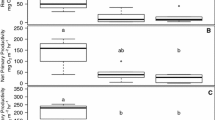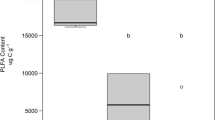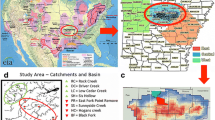Abstract
A legacy of pre-regulation coal mining in many areas has been acid mine drainage (metal-rich, low pH water). Today, numerous remediation strategies may be implemented, but there is little data on efficacy in restoring biological condition. Two alkaline doser projects in Ohio were assessed using diatom assemblages, and biofilm extracellular enzyme activities (EEA). In one stream, water quality steadily increased downstream of the doser; pH increased from 3.8 to 7.2 and Fe decreased from 107 to 0.42 mg l−1. Likewise, the periphyton biomass (chl a 7.15–12.77 mg m−2) increased and periphyton index scores (4–27) improved. As well, EEA data showed greater activity for phosphorus, nitrogen, and one carbon acquisition enzyme. For the other stream, the conductivity remained high (>720 μS cm−1) and pH and alkalinity decreased downstream. Biological data, including EEA, varied along the stream length with higher numbers in the middle reach, such as chlorophyll a (0.56 to 87.75 to 2.77 mg m−2), and index scores (7 to 29 to 11). The first remediation site showed positive results in chemistry, biological community and measures of ecosystem function. The second stream was highly variable in these parameters suggesting further AMD inputs are hampering recovery.





Similar content being viewed by others
References
Anonymous, 1997. Data Logging Colorimeter Handbook. Hach Company, Loveland, CO.
APHA, American Water Works Association & WEF, 2012. In Rice, E. W., R. B. Baird, A. D. Eaton & L. S. Clesceri (eds), Standard Methods for Examination of Water and Wastewater 2012. American Public Health Association: 1496.
Barbour, M. T., J. Gerritsen, B. B. Snyder & J. B. Stribling, 1999. Rapid Bioassessment Protocols for Use in Wadeable Rivers: Periphyton, Benthic Macroinvertebrates and Fish. 2nd edn. EPA 841-B-99-002. U.S. Environmental Protection Agency, Office of Water, Washington, D.C.
Battarbee, R. W., 1973. A new method for estimating absolute microfossil numbers with special reference to diatoms. Limnology and Oceanography 18: 647–653.
Bray, J. P., P. A. Broady, D. K. Niyogi & J. S. Harding, 2008. Periphyton communities in New Zealand streams impacted by acid mine drainage. Marine and Freshwater Research 59: 1084–1091.
Clarke, K. R., 1993. Non-parametric multivariate analyses of changes in community structure. Australian Journal of Ecology 18: 117–143.
DeForest, J. L., 2009. The influence of time, storage temperature, and substrate age on potential soil enzyme activity in acidic forest soils using MUB-linked substrates and ι-DOPA. Soil Biology and Biochemistry 41: 1180–1186.
Demchak, J., J. Skousen & L. M. McDonald, 2004. Longevity of acid discharges from underground mines located above the regional water table. Journal of Environmental Quality 33: 656–668.
Dsa, J. V., K. S. Johnson, D. Lopez, C. Kanuckel & J. Tumlinson, 2008. Residual toxicity of acid mine drainage-contaminated sediment to stream macroinvertebrates: relative contribution of acidity vs. metals. Water, Air and Soil Pollution 194: 185–197.
Farley, M., B. McCamment, D. Bryenton, B. Miller & M. Greenlee, 2004. Stream Dosing for Acid Mine Drainage Pollution at Carbondale and Jobs Hollow in Southeastern, Ohio. Ohio Department of Natural Resources, Division of Mineral Resources Management, Jackson, OH.
Gale, W. F., A. J. Gurzynski & R. L. Lowe, 1979. Colonization and standing crops of epilithic algae in the Susquehanna River, Pennsylvania. Journal of Phycology 15: 117–123.
Gazea, B., K. Adam & A. Konotopoulos, 1996. A review of passive systems for the treatment of acid mine drainage. Minerals Engineering 9: 23–42.
Hall Jr., L. W., W. D. Killen Jr., S. A. Fischer, M. C. Ziegenfuss, R. D. Anderson & R. J. Klauda, 1994. The efficacy of a limestone doser to mitigate stream acidification in a Maryland coastal plain stream: Implications for migratory fish species. Environmental Monitoring and Assessment 31: 233–257.
Hammarstrom, J. M., P. L. Sibrell & H. E. Belkin, 2003. Characterization of limestone reacted with acid-mine drainage in a pulsed limestone bed treatment system at the Friendship Hill National Historical site, Pennsylvania, USA. Applied Geochemistry 18: 1705–1721.
Hill, B. H., C. M. Elonen, T. M. Jicha, A. M. Cotter, A. S. Trebitz & N. P. Danz, 2006. Sediment microbial enzyme activity as an indicator of nutrient limitation in Great Lakes coastal wetlands. Freshwater Biology 51: 1670–1683.
Hill, B. H., C. M. Elonen, T. M. Jicha, D. W. Bolgrien & M. F. Moffett, 2010a. Sediment microbial enzyme activity as an indicator of nutrient limitation in the great rivers of the Upper Mississippi River basin. Biogeochemistry 97: 195–209.
Hill, B. H., F. H. McCormick, B. C. Harvey, S. L. Johnson, M. L. Warren & C. M. Elonen, 2010b. Microbial enzyme activity, nutrient uptake and nutrient limitation in forested streams. Freshwater Biology 55: 1005–1019.
Hill, B. H., C. M. Elonen, L. R. Seifert, A. A. May & E. Tarquinio, 2012. Microbial enzyme stoichiometry and nutrient limitation in US streams and rivers. Ecological Indicators 18: 540–551.
Hogsden, K. L. & J. S. Harding, 2012. Consequences of acid mine drainage for the structure and function of benthic stream communities: a review. Freshwater Science 31: 108–120.
Karr, J. R. & E. W. Chu, 1999. Restoring Life in Running Waters: Better Biological Monitoring. Island Press, Washington, DC.
Karr, J. R. & D. R. Dudley, 1981. Ecological perspective on water quality goals. Environmental Management 5: 55–68.
Krammer, K. & H. Lange-Bertalot, 1986. Bacillariophyceae. 2. Teil: Naviculaceae. VEB Gustav Fisher Verlag, Jena, Germany.
Krammer, K. & H. Lange-Bertalot, 1988. Bacillariophyceae. 2. Teil: Epithemiaceae, Bacillariaceae, Surirellaceae. VEB Gustav Fisher Verlag, Jena, Germany.
Krammer, K. & H. Lange-Bertalot, 1991a. Bacillariophyceae. 2. Teil: Centrales, Fragilariaceae, Eunotiaceae, Achnanthaceae. VEB Gustav Fisher Verlag, Jena, Germany.
Krammer, K. & H. Lange-Bertalot, 1991b. Bacillariophyceae. 2. Teil: Achnanthaceae, Kritische Erganzungen zu Navucula (Lineolate) und Gomphonema. VEB Gustav Fisher Verlag, Jena, Germany.
Kruse, N. A., J. R. Bowman, A. L. Mackey, B. McCament & K. S. Johnson, 2012. The lasting impacts of offline periods in lime doser streams: a case study in Raccoon, Creek, Ohio. Mine Water and the Environment 31: 266–272.
Kruskal, J. B., 1964. Multidimensional scaling by optimizing goodness of fit to a nonmetric hypothesis. Psychometrika 29: 1–27.
Lowe, R. L. & Y. Pan, 1996. Benthic algal communities as biological monitors. In Stevenson, R. J., M. L. Bothwell & R. L. Lowe (eds), Algal Ecology. Academic Press, London: 705–739.
Luís, A. T., P. Teixera, S. F. P. Almeida, J. Ector, J. X. Matos & E. A. Ferreira da Silva, 2009. Impact of acid mine drainage (AMD) on water quality, stream sediments and periphytic diatom communities in the surrounding streams of Aljustrel mining area (Portugal). Water, Air, and Soil Pollution 200: 147–167.
Mather, P. M., 1976. Computational Methods of Multivariate Analysis in Physical Geography. Wiley, London.
Mills, J. E., 1996. The north branch of the Potomac River: results from two years of lime dosing. Proceedings of the Seventeenth Annual West Virginia Surface Mine Drainage Task Force Symposium.
Monday Creek Restoration Project, 2005. Jobs Hollow doser. Up the Creek: The Monday Creek Newsletter 11: 3.
Mulholland, P. J., 1996. Role in nutrient cycling in streams. In Stevenson, R. J., M. L. Bothwell & R. L. Lowe (eds), Algal Ecology. Academic Press, London, UK: 609–639.
NPS, Nonpoint Source Monitoring Project for Acid Mine Drainage, 2011. An Evaluation of Water Quality, Biology, and Acid Mine Drainage Reclamation in Five Watersheds: Raccoon Creek, Monday Creek, Sunday Creek, Huff Run, and Leading Creek. Voinovich School of Leadership and Public Affairs at Ohio University.
Patrick, R. & C. W. Reimer, 1966. The Diatoms of the United States, Vol. 1. Monographs of the Academy of Natural Sciences of Philadelphia. No. 13.
Rice, C., J. B. Hoy, R. Hoy, J. Last, M. Farley, J. Grow, M. Knapp & K. Simon, 2002. Acid Mine Drainage Abatement and Treatment (AMDAT) Plan for the Headwaters of the Raccoon Creek Watershed. Raccoon Creek Partnership, Athens.
Rier, S. T., K. A. Kuehn & S. N. Francoeur, 2007. Algal regulation of extracellular enzyme activity in stream microbial communities associated with inert substrata and detritus. Journal of the North American Benthological Society 26: 439–449.
Shackle, V. J., C. Freeman & B. Reynolds, 2000. Carbon supply and the regulation of enzyme activity in constructed wetlands. Soil Biology and Biochemistry 32: 1935–1940.
Singer, P. C. & W. Stumm, 1970. Acid mine drainage: the rate-determining step. Science 167: 1121–1123.
Sinsabaugh, R. L. & C. M. Foreman, 2001. Activity profiles of bacterioplankton in a eutrophic river. Freshwater Biology 46: 1239–1249.
Sinsabaugh, R. L., R. K. Antibus & A. E. Linkins, 1991. An enzymic approach to the analysis of microbial activity during plant litter decomposition. Agriculture, Ecosystems, and Environment 34: 43–54.
Skousen, J., A. Sexstone & P. F. Ziemkiewicz, 2000. Acid mine drainage control and treatment. In Barnhisel, R., et al. (eds), Reclamation of Drastically Disturbed Lands. American Society of Agronomy and American Society for Surface Mining and Reclamation, Madison, WI: 131–168.
Smucker, N. J. & M. L. Vis, 2009. Use of diatoms to assess agricultural and coal mining impacts on streams and a multiassemblage case study. Journal of the North American Benthological Society 28: 659–675.
Smucker, N. J. & M. L. Vis, 2011. Acid mine drainage affects the development and function of epilithic biofilms in streams. Journal of the North American Benthological Society 30: 728–738.
Smucker, N. J., J. L. DeForest & M. L. Vis, 2009. Different methods and storage duration affect measurements of epilithic extracellular enzyme activities in lotic biofilms. Hydrobiologia 636: 153–162.
Sterner, R. W. & D. O. Hessen, 1994. Algal nutrient limitation and the nutrition of aquatic herbivores. Annual Review of Ecology and Systematics 25: 1–29.
Stoermer, E. F., M. B. Edlund, C. H. Pilskaln & C. L. Schelske, 1995. Siliceous microfossil distribution in the surficial sediments of Lake Baikal. Journal of Paleolimnology 14: 69–82.
Turnipseed, D. P. & V. B. Sauer, 2010, Discharge Measurements at Gaging Stations: U.S. Geological Survey Techniques and Methods Book 3, Chap. A8: 87.
United States Government, 1977. Surface Mining Control and Reclamation Act. Public Law 95-87. U.S.C 1201 et. seq. U.S. Government, Washington, DC.
US EPA, 1995. Streams With Fisheries Impacted by Acid Mine Drainage in MD, OH, PA, VA, and WV. USEPA Region III, Wheeling, WV.
USGS, 2001. Techniques for Estimating Selected Streamflow Characteristics of Rural Unregulated Streams in Ohio, Water Resources Investigation Report 02-4068. United States Geological Survey, Columbus, OH.
Verb, R. G. & M. L. Vis, 2005. Periphyton assemblages as bioindicators of mine-drainage in unglaciated Western Allegheny Plateau lotic systems. Water, Air, and Soil Pollution 161: 227–265.
Wang, Y. K., R. J. Stevenson & L. Metzmeier, 2005. Development and evaluation of a diatom based index of biotic integrity for the interior plateau ecoregion, USA. Journal of the North American Benthological Society 24: 990–1008.
Young, R. G., C. D. Matthaei & C. R. Townsend, 2008. Organic matter breakdown and ecosystem metabolism: functional indicators for assessing river ecosystem health. Journal of the North American Benthological Society 27: 605–625.
Zalack, J. T., 2006. Thesis: Development of a Diatom Based Index of Biotic Integrity for Acid Mine Drainage Impacted Streams. Ohio University, Athens, OH.
Zalack, J. T., N. J. Smucker & M. L. Vis, 2010. Development of a diatom based index of biotic integrity for acid mine drainage impacted streams. Ecological Indicators 10: 287–295.
Acknowledgments
We thank the Raccoon Creek Partnership for Hewett Fork and the Monday Creek Restoration Project for Monday Creek for providing water chemistry data. A special thanks to Molly Semones and Nate Smucker for field and laboratory assistance and Jared DeForest graciously allowed use of laboratory equipment. Comments by Kelly Johnson and Jared DeForest on an earlier version of this manuscript and those from Nate Smucker and two anonymous reviewers on the manuscript greatly improved the manuscript. From the Voinovich School of Leadership and Public Affairs, we thank Steven Porter, Data and GIS Specialist for creating Figs. 1 and 2 and Jen Bowman, Environmental Project Manager, for facilitating the research. Funding for this research was provided by an Ohio University Graduate Student Senate Original Work Grant, a Biological Restorability Research Challenge grant, and the Department of Environmental and Plant Biology.
Author information
Authors and Affiliations
Corresponding author
Additional information
Handling editor: Nicholas R. Bond
Electronic supplementary material
Below is the link to the electronic supplementary material.
Rights and permissions
About this article
Cite this article
Pool, J.R., Kruse, N.A. & Vis, M.L. Assessment of mine drainage remediated streams using diatom assemblages and biofilm enzyme activities. Hydrobiologia 709, 101–116 (2013). https://doi.org/10.1007/s10750-012-1440-2
Received:
Revised:
Accepted:
Published:
Issue Date:
DOI: https://doi.org/10.1007/s10750-012-1440-2




